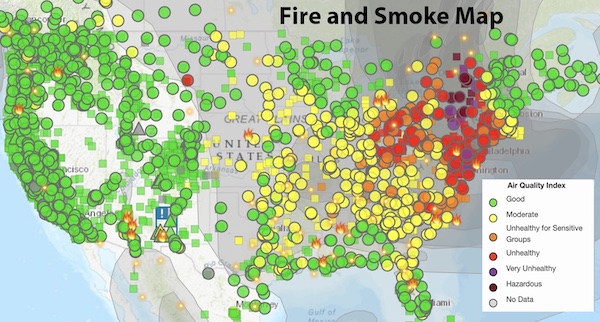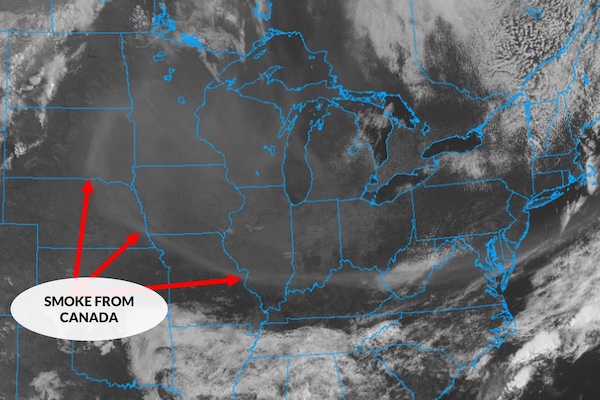Wildfires and their related troubles in the US have typically been concentrated in Western states. This year, however, record wildfires in eastern Canada are impacting parts of the Northeast and Midwest. Smoke from the fires is blamed for New York City’s air quality recently ranking as among the worst in the world. The smoke has reached as far south as Florida and as far west as Texas, while casting a haze over critical ag states like Iowa, Illinois, Michigan, and Ohio.
Canada is actually battling thousands of fires right now that stretch across the entire country, but it’s the ones in the eastern provinces that are vexing US states. It’s on track to be the worst wildfire season on record with models showing Canada’s wildfire risks continuing to rise through August. According to Quebec’s fire prevention agency, in an average year by this time, the province sees around 750 acres burned. But this year, more than half a million acres (872 square miles) have already burned.
Serious air quality alerts have been issued in at least 13 states at various points over the past few weeks. Even at low concentrations, wildfire smoke can be a health hazard. Wildfire smoke is made up of a complex mixture of fine particles and gases. Smoke is very irritating to the eyes, nose, and throat, but the fine particles pose the largest threat to health. Due to their tiny size, fine particles can more easily reach and penetrate the lungs when inhaled.
As the fine particles travel deep into the respiratory tract, they can cause various short and long-term health problems. Shortness of breath and respiratory irritation are common effects. They can also worsen existing health conditions, such as asthma and heart disease. Additionally, wildfires release large amounts of mercury into the atmosphere, which can cause muscle weakness, as well as vision and speech impairment for people of all ages. Smoke also contains a number of harmful gases, the most dangerous being carbon monoxide, which decreases the body’s oxygen supply, leading to headaches and reduced alertness.
The health effects of smoke from wildfires can be damaging to everyone – even healthy people. However, certain demographics should take extra precautions against inhaling wildfire smoke, including infants and young children, pregnant women, older people, and those with chronic diseases.
Many factors can dictate how wildfire smoke will affect you. The concentration of smoke, duration of exposure, and proximity to the fire can affect the severity of symptoms. Although everyone has a different sensitivity to smoke, it is always a good idea to avoid breathing it in as much as possible.
Unfortunately for farmers, staying indoors is not a practical option, especially this time of year. That means it is important to be aware of the warning signs that indicate wildfire smoke is starting to negatively affect you. In the short-term, that typically includes a runny nose and irritated eyes and throat. Decreased lung function, coughing, and wheezing are also symptoms of wildfire smoke exposure. Longer-term, exposure to wildfire smoke can cause pulmonary inflammation and aggravations of many pre-existing health conditions such as asthma, bronchitis, and lung disease. It can also worsen existing cardiovascular diseases, which can lead to heart failure.
To reduce exposure outdoors, experts recommend first checking local air quality, which can vary widely from day to day. Most agencies use color-coded systems, with green typically the best and red indicating the worst. If your area is under an air quality alert, consider wearing an N95 mask, which will help filter out many of the fine particles and harmful chemicals that may accompany the smoke.
To make your home safer, keep windows, doors, and even fireplaces shut. The US EPA says it’s also a good idea to get familiar with your HVAC or air conditioner system, if you have one, so you can adjust it to keep smoke out. Using a portable air cleaner can also reduce your exposure to smoke hazards. More details about how to keep you and your family safe are available from the EPA HERE.
As for how the drifting smoke might impact US agriculture, much of that depends on how long the current conditions last. Livestock is particularly at risk as smoke impacts them much like it does humans. That means producers need to be on the lookout for similar symptoms of respiratory irritation.
The impact of wildfire smoke on crops is more complicated, with both pros and cons. According to Mark Jeschke, Ph.D., Agronomy Manager at Pioneer, the negative threats include reduced total solar radiation and elevated ozone. Ample sunlight is critical for maximizing plant photosynthesis and crop yield, and lower-than-normal solar radiation during grain fill can be detrimental. Jeschke says corn, in particular, is susceptible to reduced yields and reduced standability if the plants need to remobilize carbohydrates from the stalk to make up for a deficit in photosynthesis. This weakens the stalks and opens the door for stalk rot pathogen.
At the same time, Jeschke says wildfire smoke can significantly increase the diffuse fraction of photosynthetically active radiation (PAR), which can actually benefit plants by increasing their light use efficiency. The potential effect of more diffuse light on plant growth depends on the characteristics of the plant canopy, with taller, higher leaf area index, and multilayer canopies likely to benefit more from diffuse radiation than shorter plants. More details are available HERE. (Sources: WFCA, Corteva, Reuters, USDA)










